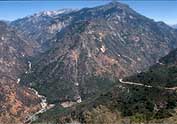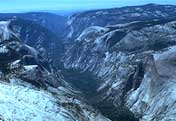 V-shaped valleys |
 U-shaped valley |
National Parks and Glaciers
A great number of national parks and monuments of the United States were affected by either Alpine or Continental Glaciation. In general, those parks which lie in more northerly latitudes were affected by continental glaciation (Voyageurs NP in Minnesota, Apostle Islands National Lakeshore in Wisconsin, Acadia NP in Maine) whereas just about all the mountain parks experienced some degree of alpine glaciation. Kings Canyon and Sequoia National Parks in southeastern California were heavily glaciated--even the top of Mauna Kea Volcano, just north of Hawaii Volcanoes National Park, was glaciated!
In this course, we're concerned primarily with how glaciers affect the landscape and how and why glaciers move. Additionally, the glacial record in many national parks and monuments can tell us a great deal about climate fluctuations during the last two million years.
Glaciers affect the landscape through erosion and deposition. The most dramatic landforms, however, are erosional. These features include cirques and headwalls, horns, aretes--all of which work together to create an extremely rugged landscape. Also, as glaciers scour the older river valleys down which they move, oversteepening the sides to give the valley a U-shaped profile. The two photos below compare the typical v-shaped profile of a river valley to the U-shape of one that's been glaciated.
 V-shaped valleys |
 U-shaped valley |
Moraines, probably the most common glacial depositional features in national parks, consist of large deposits of glacial till. Moraines typically form large linear hills, and in some cases, can hold back lakes. Ground moraines, typical of continental glaciations, can cover vast areas and are locally pockmarked by kettle lakes.
go to Glacial Geology page for more.
return to National Parks